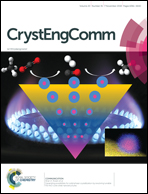Inter-diffusion of Cu2+ ions into CuS nanocrystals confines the microwave absorption properties†
Abstract
We report inter-diffusion of as-synthesized covellite CuS nanocrystals (NCs) with Cu2+ cations at room temperature in the presence of a mild reducing agent (i.e., ascorbic acid). Unlike the previously-reported incorporation of Cu+ or Cu2+ ions with CuS that generates homogenous Cu2−xS NCs, the controlled diffusion of Cu2+ ions into the CuS NCs allows the formation of a unique CuS@Cu2−xS core–shell-like nanostructure as the intermediate and Cu2S NCs in the presence of excess Cu2+ ions. The CuS@Cu2−xS core–shell nanostructure can evolve into homogenous Cu2−xS NCs by further cation diffusion from the Cu2−xS shell toward the center (i.e. the CuS core) under E-beam irradiation during TEM test or when the core–shell NCs are stored in toluene for some time (e.g. four weeks). Notably, the CuS/paraffin composite with filler loading of 50 wt% and thickness of 1.95 mm displays a minimum reflection loss (RL) of −54.84 dB at 12.6 GHz. By adjusting the thickness in the range of 1–5 mm, the effective absorption bandwidth (below −10 dB, 90% microwave absorption) could reach 15 GHz (3–18 GHz). In particular, the diffusion of Cu2+ into CuS NCs leads to dampening of the NIR plasmon absorbance and a decrease in free carrier (i.e., hole) density and conductivity, which accounts for the confinement effect on the microwave absorption properties of the resulting samples.



 Please wait while we load your content...
Please wait while we load your content...